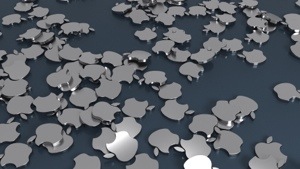Since the passing of Steve Jobs people have speculated about the future of Apple. Over the last two years the media (and Wall Street) have continually raised expectations for Apple to innovate and introduce a whole new product line. Revolutionize a whole untapped market/industry and wow the world. But, is this really what Apple should be doing?
The Apple brand
The reputation of Apple globally is very much associated with the iPhone and iPad product lines, but these product lines have only been around for the last 6-7 years in a corporate lifespan of 30 years+.
The one thing that Apple embodies is “excellence in design“. Everything else Apple is known for starts with this principle. Now Apple hasn’t always had that focus front and centre but this mantra has definitely been emphasized since Steve Jobs return and even more so with Jony Ive leading design – the later still true today.
Operational excellence was led for years by Tim Cook. During the 2000s, he built up the vast machinery that churns out the millions of iPods/iPhones/iPads not to mention MacBooks.
Excellence in post-sales customer service further supports the quality product designs of Apple. The Apple Store retail strategy is part of the delivery and Apple’s desire to control these parts of the customer experience. Steve Jobs had correctly identified the then weakness that Apple had no control over how Macs were sold so he/Apple took control.
Design excellence has been a constant goal. The internal reorganization and shift of power to Jony Ive’s design group is a realization of this goal. Under this leadership product designs are meticulous and go beyond to cover the packaging and unboxing experience. The manufacturing processes and materials engineering are unparalleled which further enhance Apple’s competitive advantage. Reading the recent book written up on Jony Ive reveals how Apple has invested $billions on a scale that no other company has undertaken – all to achieve mass precision manufacturing. Today we see and benefit from this focus on perfect design in the unibody MacBooks and iMacs. The pursuit of design perfection backed by a $100B+ cash-pile puts Apple in a league of its own.
The expectations set by Wall Street analysts these days seems to focus on an unsustainable series of expectations. If one were to analyst the financials of Apple without knowing it was Apple, you would rate the company highly across the board. The problem is that Apple is not only expected to better itself, but outperform even that high expectation!
Apple (and of late Amazon) are top performing companies who have consistently performed well and yet the stock market and share price would suggest analysts and shareholders don’t agree…
The smartphone wars is simplified into Android vs iOS. Whilst Android may now dominate in terms of sheer numbers, other more important measures of success indicate Apple continues to maintain the lead. Specifically, the profit margins Apple tracks creates a first mover advantage. This reality is locked in as start-up developers will continue to develop first for iOS in the hope of succeeding through the rounds of capital funding before considering porting to other platforms like Android. Consistent reports demonstrate us Apple end-users are a click-happy higher-spend segment of the market compared to the fragmented and less-engaged Android users. Adoption rates of the latest software updates reflect the solid bulk ward of iOS services, with their record levels of adoption of latest updates.
The iOS ecosystem is not just an easily device scalable model but it is also geared to support developers and content producers (via iBooks). In this way, Apple has created a system that works for all parties, not just consumers.
Apple hasn’t just thought about its customers – they have also innovated in the retail channel to leverage their devices and software to provide easy POS experiences. The Apple Store app reveals just how far Apple is continuously pushing the boundary – through the automatic scanning and billing of a product in-store and even in the scanning of an iTunes card as part of the redemption process. It’s no surprise that the US Apple Stores top the retail sales per square metre lists, bringing in $1m+ a day!
Apple originally competed with IBM for PC hardware. Microsoft was initially a partner, later software adversary, only for Apple to admit defeat (Internet Explorer for a time worked on Apple Macs in the late 1990s). Throughout the 2000s, the rivalry between Apple & Microsoft manifested in the “I’m a Mac/I’m a PC” advertisement series. The iPod & iTunes product lines expanded the competitive frontline to Sony and Creative – manufacturers of rival Music players. The iPhone birthed the smartphone wars and ignited new battles which ultimately persist through to today via Samsung & Google. Google forms the third side to the Apple-Microsoft-Google dynamics that dominate the technology industry. All three companies have generated huge war chests of cash over the years.
From a historical perspective Apple and Microsoft are of the same generation, who grew up and prospered throughout the 1980s. Following the generation analogy through, IBM and Xerox represent the earlier generation which worked hard and on whose shoulders stand successive generations. Google & Facebook represent the latest generation, generating huge amounts of intangible value including an M&A corporate strategy in recent times to fuel growth.
Apple today has expanded well and truly away from being a computer manufacturer to encompass software, music & media distribution, smartphones and tablets. Apple has remained true and dedicated to the premium end of town, constantly refusing to enter the low cost mass volume market. This identity still remains true in spite of the increasingly mainstream forage that the iPhone and iPad products introduced. Apple remains ever committed to designing easy to use consumer electronics that find relevance and convenience in homes, public transport, schools and businesses.

